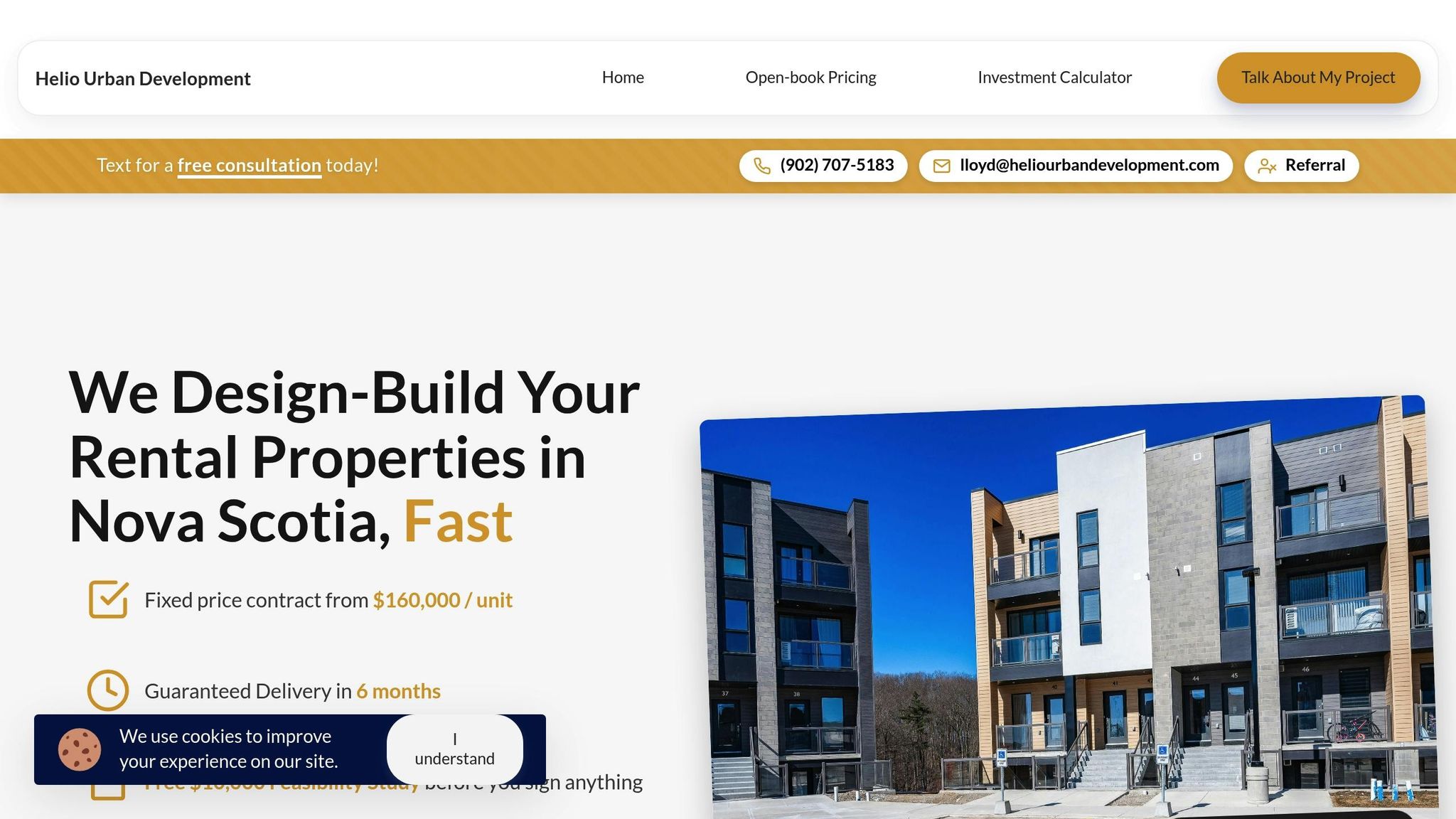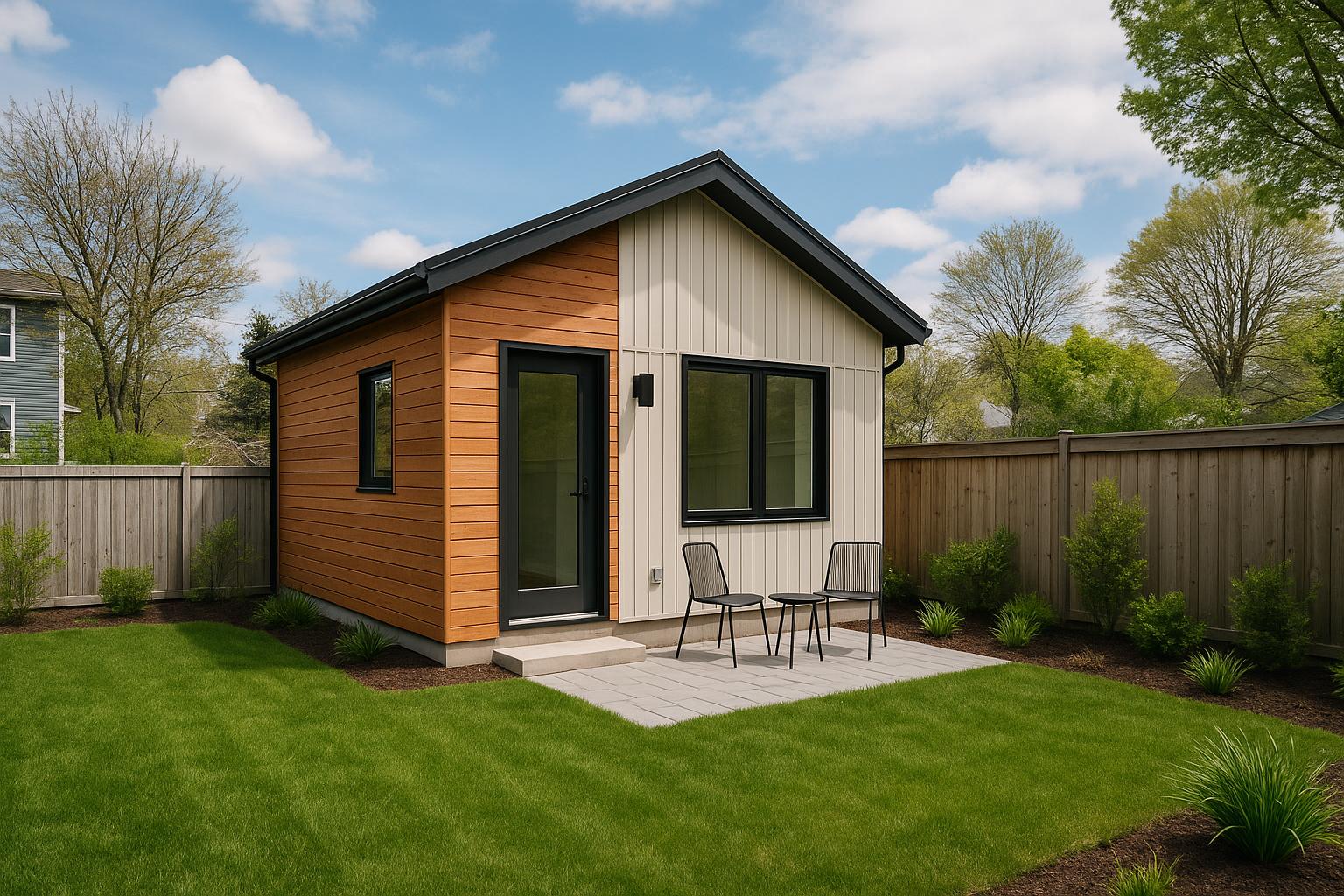Navigating the variance application process in Nova Scotia is essential if your multi-unit rental project doesn’t fit municipal zoning rules. A variance allows you to request adjustments to by-law requirements like setbacks, lot coverage, or yard size. Success depends on a strong application, clear justifications, and adherence to municipal guidelines.
Key steps include:
- Understanding Variances: Minor variances (small adjustments), major variances (larger changes), or development agreements (custom solutions).
- Required Documents: Site plans, building plans, and municipality-specific forms.
- Crafting Justifications: Prove hardships, align with by-law intent, and address community impact.
- Approval Process: Public notification, potential appeals, and meeting conditions.
Collaborating with a unified team - planners, architects, and engineers - can streamline the process, reduce errors, and help secure timely approvals.
How Variance Applications Work in Nova Scotia
What is a Variance?
A variance is a formal request to adjust specific rules outlined in your municipality's Land Use By-law. Nova Scotia municipalities operate under the Municipal Government Act [2][3], which allows limited flexibility when technical details of a project don't align with by-law standards. For multi-unit developments, variances are often necessary when the project fits within the zoning designation but doesn't meet every detailed requirement. For example, you might need to adjust setbacks, building height, or density to make your project feasible. Depending on the type of variance, the approval process can vary, as explored in the next section.
Types of Variances for Multi-Unit Construction
When it comes to multi-unit projects, there are three main types of variance requests:
- Minor Variances: These involve small adjustments, such as reducing setbacks or slightly increasing building height. Typically, these are approved by planning staff or a designated development officer without needing council involvement.
- Major Variances: These are for more substantial changes, like altering lot coverage or parking requirements. Major variances require formal approval from the municipal council, often involving a public notification process.
- Development Agreements: For projects with unique challenges that don’t fit within standard variance categories, development agreements provide a customized solution. These agreements are negotiated on a case-by-case basis and require municipal council approval following a formal public process.
Here’s a quick summary:
| Variance Type | Typical Examples | Approval Authority |
|---|---|---|
| Minor Variances | Setback or height adjustments | Planning staff or development officer |
| Major Variances | Significant zoning modifications | Municipal council |
| Development Agreements | Custom terms for unique challenges | Municipal council after public process |
Legal and Procedural Framework
Nova Scotia’s variance process is structured to balance flexibility for property owners with the broader interests of the community. One key aspect is public notification. Municipalities are required to inform nearby property owners and post public notices according to provincial guidelines. When reviewing a variance request, municipal councils assess whether the proposal aligns with the zoning by-law’s overall intent, fits the site’s specific conditions, and avoids negatively affecting neighbouring properties [2].
If your variance is denied, you can appeal the decision within 14 days to the Nova Scotia Utility and Review Board. Similarly, if a variance is approved and neighbours or other parties object, they also have the right to appeal [3].
Understanding these steps is crucial for planning your project effectively. Simpler requests, like minor variances, are typically processed faster than more complex development agreements. With this legal framework in mind, you’ll be better prepared to assemble a thorough variance application package.
How-To Guide: Variance Applications
What to Include in Your Variance Application Package
Putting together a variance application package means following your municipality's documentation rules to the letter. Accurate and complete paperwork is crucial to keep the approval process moving smoothly. Missing or incomplete documents can lead to delays or even outright rejection.
Required Documents Checklist
Start with the essentials. Use the most up-to-date municipal forms to clearly outline your project's scope and explain why the variance is needed.
Include site and plot plans that detail property boundaries, existing structures, and the proposed changes. For instance, in the Municipality of Yarmouth, building permits require these plans to be submitted [4].
Make sure to check the specific requirements for your municipality and include all necessary documents to avoid setbacks.
Municipality-Specific Requirements
Each municipality in Nova Scotia has its own set of rules. In the Municipality of Yarmouth, for example, you’ll need a Development Permit for any lot development and a Building Permit for structures over 20 square metres or for renovations valued at $5,000 or more [4]. Meeting these local requirements can help you avoid delays in getting your application approved.
If your project involves professionals like engineers, architects, or interior designers, include Schedule "A" Letters of Undertaking as part of your submission.
Submission Standards and Formatting
When submitting your application to municipalities in Nova Scotia, make sure to use metric measurements. Dimensions should be listed in metres, areas in square metres, and temperatures in Celsius.
Additionally, include Building Plans and pay the required Building Permit Fees when applying for Building Permits. Approvals will depend on the details provided in your building plans [4].
Once your documentation meets all municipal standards, the next step is to craft clear and persuasive justifications for your variance request.
Writing Strong Justifications for Variance Requests
A well-argued justification is the cornerstone of any variance application. It must persuade municipal officials that approving your request aligns with both your needs and the community's broader planning objectives. A thorough justification not only addresses specific legal requirements but also ensures your project respects the neighbourhood's character.
Key Elements of a Strong Justification
To build a compelling case, focus on these critical elements:
- Prove unnecessary hardship: Demonstrate that strict application of zoning rules creates genuine difficulties in using your property. These hardships must stem from unique property characteristics or circumstances beyond your control - not from actions or decisions you’ve made [5][6].
- Align with the bylaw's intent: Show that your request respects the purpose of the zoning regulation, even if it takes a slightly different approach. Make it clear that your proposal addresses the hardship while keeping changes to the bare minimum [6][7].
- Preserve neighbourhood character: Highlight how your variance maintains the area’s character and minimizes any negative impacts. Address potential concerns like privacy, traffic flow, parking, noise, and visual harmony [5][6][7].
- Avoid preferential treatment: Frame your request as a solution to unique circumstances rather than an attempt to gain an unfair advantage. Municipal officials will reject applications that seek benefits inconsistent with restrictions on similar properties in the area [7].
These strategies help ensure your justification is clear, focused, and persuasive.
Common Mistakes to Avoid
Many applications fail because they overlook key considerations. Here are some pitfalls to steer clear of:
- Focusing on financial benefits: Arguments based on cost savings or profit margins won’t convince municipal officials. They’re looking for genuine hardships, not economic preferences.
- Creating your own hardship: If you knowingly purchased a property with zoning restrictions or made changes that caused the issue, your application is likely to be rejected. Hardships must arise independently of your actions.
- Using vague or generic arguments: Statements like "this will improve the neighbourhood" or "we need more housing" lack the specificity required. Tailor your justification to the unique circumstances of your property.
- Ignoring community impact: Failing to address how your proposal affects neighbours, traffic, or infrastructure suggests a lack of consideration for the broader implications of your request.
Weak vs. Strong Justification Examples
| Weak Justification | Strong Justification | Why the Strong Version Works |
|---|---|---|
| "Building closer to the property line will save construction costs and maximize our investment return." | "An irregular property shape and a 15-metre rock outcropping create unnecessary hardship. A 1.2-metre setback reduction permits development while preserving a 4.8-metre buffer." | Focuses on site-specific physical constraints, avoids financial arguments, and provides clear measurements with consideration for neighbours. |
| "We need this variance to build more units because there's a housing shortage in the area." | "The lot's 12-metre width falls below the 15-metre minimum established when the bylaw was created for residential lots. This pre-existing non-conformity prevents reasonable multi-unit development without the requested side yard variance." | Addresses legal tests by linking hardship to pre-existing lot characteristics and zoning rules. |
| "Our architect says this design looks better and is more modern than what the current rules allow." | "The proposed 0.8-metre height variance accommodates necessary mechanical systems while the sloped roof design maintains visual compatibility with surrounding two-storey homes. The additional height occurs only over the central 40% of the building footprint." | Balances functional requirements with neighbourhood aesthetics, using specific details to justify the minimal variance. |
sbb-itb-16b8a48
Typical Approval Conditions from Municipalities
One of the main requirements for municipal variance approvals is the process of notifying neighbours and allowing for appeals. According to the Municipal Government Act, municipalities must inform the public before approving variances. This gives neighbouring property owners a chance to review the proposal and share their feedback. Following this, there’s a 14-day appeal period during which any affected party can file an appeal.
Being familiar with this process can help you plan your timeline effectively and address any concerns from neighbours early on. For more detailed information, check out the Nova Scotia government's document titled "Land Use Planning - Variance Process and Appeals" [3]. This process lays the groundwork for the next steps in getting your variance approved.
Reducing Variance Risks with an Integrated Approach
Successfully navigating the variance application process takes careful planning to avoid frustrating delays and potential rejections. The construction method you choose plays a major role in keeping your timeline and budget on track.
Fragmented vs. Integrated Construction Approaches
Let’s break it down: the traditional fragmented approach often leads to coordination headaches. Miscommunication between separate contracts can stall progress. On the other hand, an integrated design-build approach brings everyone to the table from the start. The Integrated Design Process (IDP) unites key players - owners, architects, engineers, contractors, and planners - early in the planning stage [8]. This collaborative approach ensures your variance application is complete, precise, and ready to move forward without unnecessary hiccups.
Advantages of a Unified Process
With an integrated team, you get consistent documentation and well-coordinated responses. This results in a strategic and organized variance application that reduces the chances of delays or errors. It’s a smoother, more efficient way to navigate the process.
Helio Urban Development: A Case Study in Integration

Helio Urban Development shows how an integrated model can simplify the variance application process. As Nova Scotia’s only design-build construction company specializing in 4+ unit rental properties, Helio takes a unified approach to construction. The company was founded by Lloyd Liu, a Yale MBA and former Merrill Lynch investment banker, and Yuan He, a data scientist from the University of Pennsylvania. Their personal experience with the inefficiencies of fragmented construction inspired them to create a better system.
Lloyd Liu explains, "I guarantee every timeline because I understand the delays caused by fragmented construction."
Here’s what sets Helio apart: they offer fixed-price construction at $160,000 per unit with a six-month completion guarantee. They even include penalties of up to $1,000 per day for delays. By having planners, architects, engineers, and construction teams working as one cohesive unit, Helio ensures that all variance documentation is reviewed thoroughly before submission, significantly reducing the risk of issues later on.
Helio currently serves property owners within a 90-minute radius of Halifax. Their clients typically see rental incomes of $1,950 to $2,100 per unit per month, with annual returns on investment ranging from 12% to 20%. This integrated approach not only addresses common challenges like cost uncertainties and timeline delays but also provides a more reliable path to project approval.
Getting Your Variance Approved
Getting a variance application approved boils down to three main factors: solid preparation, strong justifications, and effective teamwork. Whether your application gets the green light or not often depends on how well you navigate municipal rules and present your case.
Start by digging into the Land Use By-laws for your area. Familiarize yourself with your municipality's zoning rules and restrictions. This step is crucial - it helps you understand which variances you need and sets realistic expectations for the process [9].
Your justification is the heart of your application. You need to show how your proposed variance fits within the broader planning goals while addressing the specific challenges unique to your property. Highlight the exceptional circumstances that make your request necessary. For instance, explain any site-specific conditions that require a deviation from the rules [1]. Additionally, assess the potential impact on the community. Make a clear case that your variance will either have minimal effects or even offer benefits to the neighbourhood and surrounding areas [1]. For more complex applications, enlisting the help of a professional planner or architect can lend credibility and ensure your submission is thorough [1].
Collaboration is another key piece of the puzzle. When your planning, architectural, engineering, and construction teams work together from the start, you’re more likely to spot and address potential issues early. This kind of coordination ensures your application is complete and aligns with municipal requirements, avoiding setbacks caused by missing or conflicting information.
Once your variance is approved, meeting the attached conditions is non-negotiable. Municipalities often impose specific requirements, such as notifying neighbours, making design adjustments, or adhering to certain construction standards. Ignoring these conditions can void your approval and force you to start over.
To improve your chances of success, treat your variance application as a critical part of your overall construction plan - not just another bureaucratic step. This integrated approach not only boosts your odds of approval but also keeps your project running smoothly from start to finish.
FAQs
What are the main reasons a variance application might be rejected, and how can I prevent this?
Variance applications frequently get turned down for several reasons, such as lack of proper justification, community pushback, errors or omissions in documentation, conflicts with local by-laws, or fears of setting an unwanted precedent. To improve your chances, it’s crucial to submit an application that's thorough and carefully prepared, ensuring it meets all relevant by-laws and regulations.
Working with an expert can be invaluable - they can help you develop a solid justification that aligns with municipal standards. On top of that, connecting with the local community early on can address concerns and potentially gain their support for your project.
What happens after I submit a variance application in Nova Scotia, and how does the public notification and appeal process work?
Once your variance application gets the green light, property owners within a 30-metre radius will receive a notification by mail. They’ll have 14 days to file an appeal with the Town Council if they disagree with the decision. On the flip side, if your application is denied, you’ll have 7 days to submit your own appeal to the Town Council.
To strengthen your case, make sure your application is detailed and provides clear reasons for the variance request. A well-prepared submission can help address potential public concerns and increase your chances of a smooth approval.
What are the benefits of using a design-build approach for variance applications compared to traditional construction methods?
Using a design-build approach for variance applications comes with some clear perks compared to traditional construction methods. One major plus? You only deal with a single point of accountability. This makes communication simpler and helps avoid delays or confusion caused by misaligned goals. The result? A faster, more efficient process for getting those all-important approvals.
Another standout advantage is cost predictability. With design-build, you often get a guaranteed maximum price early on, making it easier to plan your budget and steer clear of surprise expenses. Plus, because the design and construction teams work together from the start, collaboration improves. This teamwork means fewer revisions, less back-and-forth, and a much smoother experience overall.



